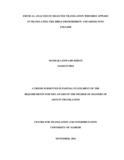| dc.contributor.author | Kireti, Mashaka E | |
| dc.date.accessioned | 2017-01-10T11:17:02Z | |
| dc.date.available | 2017-01-10T11:17:02Z | |
| dc.date.issued | 2016-11 | |
| dc.identifier.uri | http://hdl.handle.net/11295/100189 | |
| dc.description.abstract | The purpose of this research is to firstly explore the different theories which were applied in the translation of the Bible from the original languages (Greek and Hebrew) into the different versions of the English Bible. We aimed to critically look at the application of each of the three theories under study (Formal equivalence, dynamic equivalence and free translation) and the possible impediments of each to the intelligibility of the message vis-à-vis remaining faithful to the original text. Here, we looked at the aspects of remaining faithful to the historical context as naturalness.
The research set out to investigate the two aspects (faithfulness to historical context and naturalness) in relation to the translation theory applied in translating the Bible. Texts were selected purposively from the book of Job and Psalms in the Old Testament and others from the New Testament. After text analysis, the findings on how the application of a given translation theory were recorded. | en_US |
| dc.language.iso | en | en_US |
| dc.publisher | University of Nairobi | en_US |
| dc.rights | Attribution-NonCommercial-NoDerivs 3.0 United States | * |
| dc.rights.uri | http://creativecommons.org/licenses/by-nc-nd/3.0/us/ | * |
| dc.subject | Translation Theories Applied In Translating The Bible From Hebrew And Greek Into English | en_US |
| dc.title | Critical Analysis of Selected Translation Theories Applied in Translating the Bible From Hebrew and Greek Into English | en_US |
| dc.type | Thesis | en_US |



